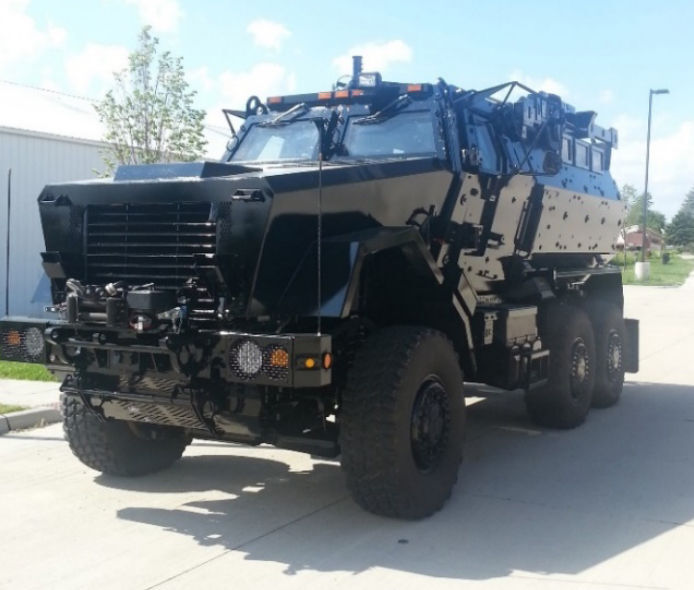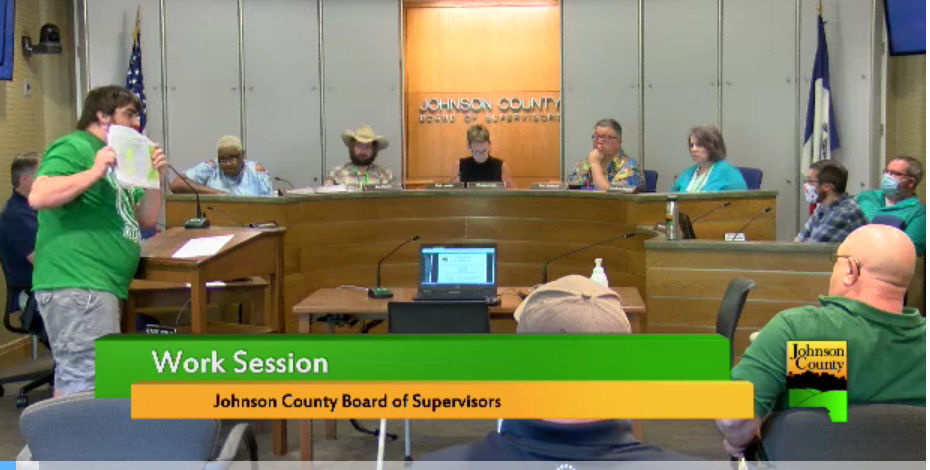JOHNSON COUNTY — In 2014 the Johnson County Sheriff’s Office (JCSO) received a Mine Resistant Ambush Protected (MRAP) six-wheel drive armored truck from the Department of Defense through the controversial — 1033 Program.
Under the 1033 Program the Defense Logistics Agency provides military equipment through The Law Enforcement Support Office (LESO). The LESO was born in the National Defense Authorization Act of 1997, which allows for excess or surplus Department of Defense (DoD) property to be transferred to law enforcement. Congress authorized the federal government in 1990 and 1991 to transfer excess DoD property to state agencies to combat drug activities. The 1997 authorization expanded the transfer of equipment to all law enforcement agencies. However, preference was still given to counter-drug and counter-terrorism requests.
Equipment made available through the 1033 Program includes office furniture, commercial/industrial grade appliances, exercise equipment, generators, tents, general law enforcement equipment, All-Terrain Vehicles (ATVs), cranes, various trucks, and tactical vehicles such as HUMVEEs and the newer MRAPs. The only expenses to the law enforcement agencies are transportation and any modifications they choose to make. In Johnson County’s case, the vehicle had been completely refurbished to factory-new condition, minus military-specific equipment such as armament. The vehicle was painted black locally, and had emergency vehicle lights and radio equipment installed for its new role. At the time, then-Sheriff Lonny Pulkrabek described the truck as, “…simply another tool on the tool belt for law enforcement. I don’t think of it as anything more or anything less than a tool. There are a lot of people in this world who have evil ideas, evil thoughts, and evil actions and we’re on the front lines for dealing with that evil.”
Sheriff Brad Kunkel provided an update on the use of the vehicle to the Johnson County Board of Supervisors during their Wednesday, June 16 work session.
“There has been some renewed interest, to say the least, in the MRAP,” Kunkel said. “It’s unfortunate we wind up with a lot of mischaracterizations about the MRAP and how we utilize it, and the resource it is to the Sheriff’s Office.” He reiterated despite the vehicle’s military origin it has no military features. “It doesn’t have a water cannon. It doesn’t have firearms that are deployable. It simply moves people and provides protection. It is a large, bulletproof box that moves our folks in and out of trouble, and also the public if we need to remove them from an area with gunfire.”
The Sheriff stressed, “It is not a tank. That’s an unfortunate mischaracterization. I think we can all easily look and understand, and Google…what a ‘tank’ is compared to a large rubber-tired vehicle (without any mounted weaponry).”
The JCSO has specially trained operators for the truck, and Kunkle noted he was not among them. “I don’t drive it I couldn’t tell you how to start it.” He pointed out the vehicle’s 52,000-pound weight is less than the Iowa City Fire Department’s aerial ladder truck, allaying fears of damage to streets and roads, and acknowledged the truck averages five-to-seven miles per gallon of diesel fuel, which some have cited as environmentally unfriendly. Kunkel also pointed out the MRAP is the only piece of equipment the JCSO has received from the 1033 Program.
“We do share it with other agencies,” he said, which means some of the maintenance and operational costs are shared. To date, Kunkel said, maintenance costs since 2014 have totaled approximately $4,000 with an annual liability insurance premium of $1,163, which is paid by the Johnson County Emergency Management Agency (EMA). The initial $13,000 cost of transportation, painting, and equipping for use by the Sheriff’s Office was paid for out of drug forfeiture money, “So there weren’t any tax dollars used.”
Typically, the Sheriff said, the vehicle is kept on standby for Special Response Team (SRT) callouts, which are high-risk incidents involving the danger of offenders with firearms. It is staged (parked) close to the scene of the incident and returned to service once the scene is secure. It also is deployed for active gunfire incidents such as was the case earlier this year when an armed suicidal man fired at officers in North Liberty after a vehicle chase and before barricading himself in a vacant business. Shortly after being acquired the MRAP was utilized to evacuate people trapped by rising floodwaters. “Law enforcement is often faced with dynamic situations and incident commanders and supervisors have to make decisions in the moment on how equipment is going to be utilized,” Kunkle said. Typical police vehicles offer no ballistic protection against gunfire. “Without it, we don’t have any other option to use a vehicle for cover should we need it.”
Since 2014 the MRAP has been deployed 19 times with 16 being for shooting, homicide, or other firearms related investigations. It was deployed on standby in June 2020 during protests in Iowa City and Coralville, and has responded to two incidents where shots were fired at officers. Kunkel presented a record of the vehicle’s deployments (visible with his presentation on the Johnson County Supervisors’ webpage via the 6-17-21 agenda). “The common denominator in just about all of them is shootings or gunfire. The reason it is utilized is because firearms are likely present in these situations. We have that resource available to protect everyone should firearms be used against them.” He also noted the incidents are scattered throughout Iowa City, Coralville, North Liberty, and rural Johnson County.
The MRAP, and the idea of law enforcement agencies utilizing military equipment in general, has been controversial with criticisms from both sides of the political spectrum. In 2014 Sheriff Pulkrabek noted, “There is a need, unfortunately, for armored vehicles. No matter what people may say. Usually, the people talking about it aren’t the ones who’ll be going into a hot scene. It’ll be us. We are a reactionary business. We react to what we are called to. And, having the ability to react in different, appropriate means is a benefit.”
One such detractor, Dan Kauble, a resident of Iowa City, has been an outspoken critic of the MRAP and addressed the Supervisors during public comments. Kauble disagreed with the statement the vehicle has no offensive capabilities. “I would just like to say that leaves out the psychological effects such vehicles have on the mindsets of the public.” He also disagreed with Kunkle’s statement the vehicle isn’t a tank. “Well, tell that to the children in the neighborhoods where it’s deployed who ask their parents why is this tank coming through our neighborhood … it very clearly is a military vehicle that packs the same kind of terror as a tank. The overwhelming public perception of this vehicle is negative since they do believe it is a military vehicle.”
Kauble said he opposes the MRAP, and would do so even if he were a vocal supporter of law enforcement, “Because it does erode public trust in the institutions of law enforcement.” He called upon the Supervisors to discontinue funding for the insurance and maintenance, and instead redirect those dollars “back into the community instead of being used to terrorize them. And at the end of the day, this is what we’re talking about; terrorism.” Kauble also called pointing out use of the vehicle during flooding as “sugarcoating,” and was visibly upset as he pointed to “BIPOC neighborhoods” where the truck had been deployed, and claimed “there aren’t any white neighborhoods (on the deployment list).”
Board Chairwoman Pat Heiden noted while it’s not a tank, “It’s a big, big vehicle, and I can’t imagine looking at something like that coming down my neighborhood street. But I appreciate you saying over and over, above all else, you want to ensure your deputies get home at night. Is there any other alternative to keep deputies safe? But again, this is a massive vehicle.” Many law enforcement agencies, such as the Cedar Rapids Police Department and Linn County Sheriff’s Office, use a smaller (roughly the size of an ambulance) commercially available truck called a Bearcat. “They run about $200,000 to start, and then with options, I want to say you get up around $300,000. So that option is out there. I’m happy to pursue that if I’ve got the blessing to go down that road. I have the money in the budget, but I would certainly want to have that conversation on another day if we want to do that.” However, “Unless that is on the table, the MRAP is going to stay.”
Supervisor Royceann Porter expressed her concerns with inconsistency in the use of the MRAP, particularly in minority neighborhoods, and supported replacing it with a Bearcat.
Kunkel said when he was campaigning for Sheriff, he spoke with several police chiefs and sheriffs looking for advice. One Chief told him, “What keeps me up at night is making sure my people have everything they need: the training, the tools, and the resources they need, so they can go home.” Kunkel said, “That has stuck with me, because that is paramount to anybody running a law enforcement agency, and being responsible for law enforcement and the public. That’s what this vehicle provides.”
Chairwoman Heiden asked the Board for consensus to direct Kunkle to explore acquiring a Bearcat as a direct replacement for the MRAP. Supervisors Porter, Rod Sullivan, Heiden, and Lisa Green Douglass were in support while new member Jon Green stated he needed time to “reflect and do some additional research.” To Sheriff Kunkle, Heiden said, “You’ve got some direction and we’ll continue to have this discussion.”
If the MRAP were replaced, it would be returned to the federal government for re-issuance to another agency.
Dan Kauble voiced his opposition and fears of the County’s Mine Resistant Ambush Protected (MRAP) vehicle, operated by the Sheriff’s Office, during a June 16 work session of the County Board of Supervisors


